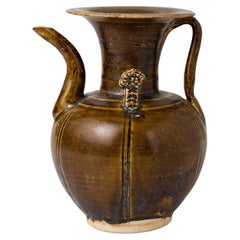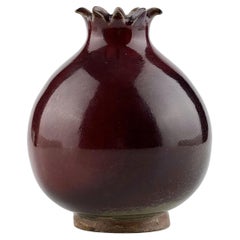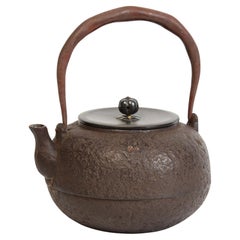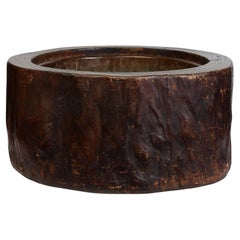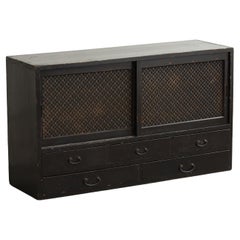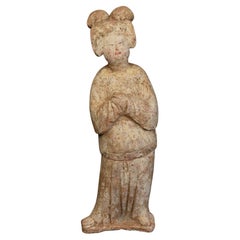Asia - Antiquities
to
463
773
882
423
759
13
1
2
1
1
423
174
162
14
116
12
1
1
1
1
1
1
337
303
148
103
64
754
457
293
209
160
773
770
770
10
Item Ships From: Asia
Brown Glazed Ceramic Ewer, Five Dynasties-Song Dynasty
Located in seoul, KR
The glaze crackles, reflecting the passage of time, add to the piece's antique charm. The spout and handle are well-proportioned, and the brown glaze is evenly applied, the unique fi...
Category
15th Century and Earlier Hong Kong Antique Asia - Antiquities
Materials
Ceramic
$5,600 Sale Price
30% Off
Pomegranate Shaped Copper Red Glazed Vase, Yuan-Ming Period
Located in seoul, KR
This piece is a small ceramic vessel with a distinctive silhouette modeled after a pomegranate, notable for its full, well-balanced curves. The mouth, reminiscent of the fruit’s caly...
Category
16th Century Hong Kong Ming Antique Asia - Antiquities
Materials
Copper
$1,500 Sale Price
25% Off
19th Century, Meiji, Antique Japanese Iron Teapot with Bronze Lid
Located in Sampantawong, TH
Antique Japanese iron teapot with bronze lid.
Age: Japan, Meiji Period, 19th Century
Size: Height 19.8 C.M. / Width 17.3 C.M. / Diameter 15.5
Co...
Category
19th Century Japanese Antique Asia - Antiquities
Materials
Bronze, Iron
$1,000 Sale Price
20% Off
Late 19th Century, Meiji, Antique Japanese Keyaki Wooden Pot 'Hibachi'
Located in Sampantawong, TH
Antique Japanese Keyaki wooden Hibachi vessel.
Hibachi is a traditional Japanese heating device.
Age: Japan, Meiji Period, Late 19th Century
Size: Length 63.5 C.M. / Width 62 C.M. /...
Category
Late 19th Century Japanese Antique Asia - Antiquities
Materials
Wood
$1,560 Sale Price
20% Off
Japanese antique cabinet with wooden lattice doors, Wabi Sabi, Japandi
Located in Katori-Shi, 12
This is a tasteful Japanese-style storage shelf made in the Meiji period.
Made of durable cedar wood. The sliding door is decorated with delicate frosted glass and wooden latticewor...
Category
Early 20th Century Japanese Meiji Asia - Antiquities
Materials
Wood
Tang Dynasty, Antique Chinese Painted Pottery Fat Lady with Oxford TL Test
Located in Sampantawong, TH
Antique Chinese painted pottery fat lady with original pigments remaining.
Thermoluminescence (TL) test result from Oxford Authentication Ltd. is included.
Age: China, Tang Dynasty,...
Category
15th Century and Earlier Chinese Antique Asia - Antiquities
Materials
Pottery
17th Century, Shan, Antique Burmese Bronze Seated Buddha
Located in Sampantawong, TH
Burmese bronze Buddha sitting in Mara Vijaya (calling the earth to witness) posture on a base.
Age: Burma, Shan Period, 17th century
Size: Heig...
Category
17th Century Burmese Antique Asia - Antiquities
Materials
Bronze
$1,000 Sale Price
20% Off
19th Century, Meiji, Antique Japanese Wooden Noh Mask
Located in Sampantawong, TH
Antique Japanese wooden Noh mask.
Age: Japan, Meiji Period, 19th Century
Size: Length 20 C.M. / Width 13.9 C.M. / Thickness 8 C.M.
Condition: Nice condition overall (some expected d...
Category
19th Century Japanese Antique Asia - Antiquities
Materials
Wood
$1,320 Sale Price
20% Off
Japanese Antique Living Low Table, Wabi Sabi
Located in Katori-Shi, 12
A tasteful round low table made of oak.
It is an item from the early Showa period.
The tabletop has a firm texture and becomes more tasteful with age, giving it a deep and warm look...
Category
Early 20th Century Japanese Showa Asia - Antiquities
Materials
Wood
Primitive Japanese Wooden Stools, Wabi-Sabi
Located in Katori-Shi, 12
A small, rugged stool made of cherry wood and iron legs.
The thick seat is slightly concave toward the center, gently supporting your body.
Fine cracks and scratches remain on the su...
Category
Early 20th Century Japanese Taisho Asia - Antiquities
Materials
Wood
Japanese antique large bamboo double layered basket - wabi sabi primitive decor
Located in 常陸大宮市, JP
New finds from the farmer's barn. Japanese antique hand woven bamboo basket - can store the heavier object because of the double layered structure of thin bamboo & thick bamboo laye...
Category
Early 20th Century Japanese Showa Asia - Antiquities
Materials
Bamboo
Tibetan Antique Iron Seal
Located in 景德镇市, CN
Delve into the rich history of Tibetan culture with this Tibetan Antique Iron Seal, a remarkable artifact showcasing ancient craftsmanship and spiritu...
Category
18th Century Antique Asia - Antiquities
Materials
Iron
Japanese Antique Low Table, Wabi Sabi
Located in Katori-Shi, 12
This is an antique wooden low table from the Meiji period (1986-1912).
The curved legs are beautiful.
It was used as a workbench by craftsmen at the time.
The material is high-qual...
Category
Early 20th Century Japanese Meiji Asia - Antiquities
Materials
Wood
A Rare Large Wucai Dragons and Phoenix Jar, Ming dynasty Longqing Emperor
Located in seoul, KR
The blue dragon and the red dragon are depicted in dynamic postures, each extending its claws to grasp a ruyi pearl (如意珠). The phoenix is adorned with flowing feathers and delicate c...
Category
16th Century Hong Kong Ming Antique Asia - Antiquities
Materials
Ceramic
$10,500 Sale Price
30% Off
Japanese Antique Black folding table, Wabi-sabi, Japandi
Located in Katori-Shi, 12
A folding table made in the Taisho era.
The lacquered cherry wood has a timeless, high-quality texture and a delicate look that is not too sweet.
Its soft appearance blends gently ...
Category
Early 20th Century Japanese Taisho Asia - Antiquities
Materials
Wood
GOOD MELLOW LIMITED05, Japanese Antique side table, Wabi Sabi, Japandi
Located in Katori-Shi, 12
This series is based on the extremely popular antique coffee table that is hard to find and sells out quickly when it arrives.
The ash wood is finished with an oil coating.
This tab...
Category
2010s Japanese Taisho Asia - Antiquities
Materials
Wood
Japanese Antique Chests of Drawers , Wabi-Sabi
Located in Katori-Shi, 12
This antique Japanese chest of drawers dates back to the Meiji period.
This chest is made from sturdy cedar wood with a lacquer finish, and the iron handles add industrial elegance....
Category
Early 20th Century Japanese Meiji Asia - Antiquities
Materials
Wood
Japanese Old Rusted Toy Car "Porsche" 1960s-1980s / Figurine Wabisabi
Located in Chōsei District Nagara, JP
This is an old Japanese toy car, heavily rusted with age. Its form appears to resemble that of a Porsche, and it is believed to have been manufactured in the post‑war Showa period (1...
Category
Late 20th Century Japanese Showa Asia - Antiquities
Materials
Tin
Blue and White Porcelain Vase with Figures, 19-20th Century
Located in seoul, KR
A porcelain meiping vase decorated in underglaze cobalt blue with scholar and attendant figures in a natural landscape. The finely crackled glaze and soft brushwork evoke a sense of ...
Category
19th Century East Asian Qing Antique Asia - Antiquities
Materials
Ceramic
$1,295 Sale Price
30% Off
Japanese Antique exhibition stand, Wabi-Sabi, Japandi
Located in Katori-Shi, 12
This small display stand will subtly highlight your favorite items, such as perfumes and jewelry.
Made of high-quality keyaki wood, it has a simple yet elegant appearance.
The stain...
Category
Early 20th Century Japanese Taisho Asia - Antiquities
Materials
Wood
A Rare Dingyao Green-Glazed Dragon Dish, Liao-Song Dynasty
Located in seoul, KR
This green-glazed bowl was finely crafted with an attention to detail that highlights the skill of the Cizhou green and Ding ware potter. Its delicate form has been adorned with a dr...
Category
15th Century and Earlier Hong Kong Ming Antique Asia - Antiquities
Materials
Ceramic, Stoneware
$12,935 Sale Price
35% Off
Japanese Antique Wooden Bowl 1910s-1940s Primitive Wabi-Sabi
Located in Chiba, Chiba
This is a Japanese wooden bowl.
It is a folk craft that was used in daily life.
I don't know what kind of wood it's made of, but it's sturdy.
Since it is made by hand, it has a dist...
Category
Early 20th Century Japanese Asia - Antiquities
Materials
Wood
$300 Sale Price
40% Off
19th Century, Antique Chinese Wood Carving with Stand
Located in Sampantawong, TH
Chinese wood carving with stand
Age: China, 19th Century
Size: Height 22.5 / Width 50.8 C.M. / Thickness 5.7 C.M.
Size including stand: Height...
Category
19th Century Chinese Antique Asia - Antiquities
Materials
Wood
$760 Sale Price
20% Off
Wooden Low Table, Japanese Antique, Wabi-Sabi, Mingei
Located in Katori-Shi, 12
This is an antique wooden low table from the Meiji period.
It is thought to have once been used as a stand for a brazier, making it a valuable item that evokes the spirit of the tim...
Category
Early 20th Century Taisho Asia - Antiquities
Materials
Wood
Wooden Low Table, Japanese Antique, Wabi-Sabi, Mingei
Located in Katori-Shi, 12
This is an antique wooden low table from the Meiji period.
At the time, it was used as a workbench by craftsmen. There are traces of work that look like they were done with a hammer...
Category
Early 20th Century Meiji Asia - Antiquities
Materials
Wood
A Longquan Celadon Five-spouted Jar, Northern Song Dynasty (960~1127)
Located in seoul, KR
The jar features a round body with well-proportioned four distinct tiers and a short, stable foot. The surface is coated in a deep green Longquan celadon glaze, showcasing the sprout...
Category
15th Century and Earlier Hong Kong Antique Asia - Antiquities
Materials
Celadon
$6,175 Sale Price
35% Off
A Carved Qingbai 'Chrysanthemum' Vase, Song-Yuan Dynasty(13-14th century)
Located in seoul, KR
The ovoid body to a tall neck, the body decorated with a chrysanthemum meander, covered overall in a translucent pale blue glaze. Traces of excavation can be seen in the dirt marks o...
Category
15th Century and Earlier Hong Kong Antique Asia - Antiquities
Materials
Ceramic, Porcelain
$9,950 Sale Price
50% Off
Japanese Wall Art / Japanese objet / wabi-sabi art / primitive wall art
Located in Sammu-shi, Chiba
This is a wall art made using some of the material from an old Japanese door.
This is a wooden door reinforced with galvanized iron sheets.
It's a convenient size that doesn't take...
Category
2010s Japanese Primitive Asia - Antiquities
Materials
Tin
19th Century, Antique Thai Wooden Animal Rabbit
Located in Sampantawong, TH
Antique Thai wooden rabbit.
Age: Thailand, 19th Century
Size: Length 52 C.M. / Width 19 C.M. / Height 20 C.M.
Condition: Nice condition overall (some expected degradation due to its...
Category
19th Century Thai Antique Asia - Antiquities
Materials
Wood
$960 Sale Price
20% Off
19th Century, Antique Burmese Bronze Elephant Bell with Stand
Located in Sampantawong, TH
Burmese bronze elephant bell with stand.
Age: Burma, 19th Century
Size: Height 12.5 C.M. / Width 9 C.M.
Size including stand: Height 23.5 C.M.
Condition: Nice condition overall...
Category
19th Century Burmese Antique Asia - Antiquities
Materials
Bronze
$384 Sale Price
20% Off
14th-16th C., A Pair of Antique Sukhothai Pottery Jars with Shell from Shipwreck
Located in Sampantawong, TH
A pair of antique Sukhothai pottery jars with natural shell and barnacle from shipwreck.
Age: Thailand, Sukhothai Period, 14th - 16th Century
Size: Height 26.5 - 26.9 C.M. / Width 1...
Category
15th Century and Earlier Thai Antique Asia - Antiquities
Materials
Pottery
$1,560 Sale Price / set
20% Off
Carved Longquan Celadon Vase, Yuan-Ming Dynasty
Located in seoul, KR
A graceful baluster form with a flared mouth, a rounded body, and a slightly raised foot. The vase features two intricate handles in the shape of animal figures holding large looped ...
Category
15th Century and Earlier Hong Kong Ming Antique Asia - Antiquities
Materials
Celadon
$4,900 Sale Price
30% Off
Chinese Antique Gourd-Shaped Blue and White Porcelain Vase, Ming Period
Located in Chuo-ku, Tokyo
The bottom sign tells this vase was made in the era of Xuande emperor.
The characteristic Arabic pattern is Influenced by the Silk Road trade in Ming p...
Category
17th Century Chinese Ming Antique Asia - Antiquities
Materials
Earthenware
Japanese Old Daruma-shaped Viewing Stone / Suiseki Figurine Wabisabi
Located in Chōsei District Nagara, JP
This is an old Japanese Daruma figure stone, suiseki (viewing stone).
The place where it was found is an old house that has been built over the years. It is a folk Buddhist image tha...
Category
Mid-20th Century Japanese Showa Asia - Antiquities
Materials
Stone
A Gray Pottery Figure of a Horse, Han Dynasty
Located in seoul, KR
This particular horse sculpture exemplifies the typical pose of Han-period equine figures—a neighing steed with its mouth wide open. Like many tomb sculptures of the era, it is crafted in unglazed, with its ears, tail, and legs separately fabricated in wood or clay and slotted into pre-prepared holes. However, several distinguishing features elevate this piece beyond standard Han horse...
Category
15th Century and Earlier Hong Kong Han Antique Asia - Antiquities
Materials
Earthenware, Pottery
$3,500 Sale Price
30% Off
19th Century, Antique Tai Yai Burmese Wooden Seated Disciple / Monk
Located in Sampantawong, TH
Burmese wooden disciple seated on a base, with gilded gold and inlay of colorful glass pieces on the borders of the robe.
Age: Burmese, 19th century
Size:...
Category
19th Century Burmese Antique Asia - Antiquities
Materials
Wood
$2,000 Sale Price
20% Off
19th Century, Antique Thai Wood Carving with Stand
Located in Sampantawong, TH
Antique Thai wood carving with angel, carved as Naga under leaf-shape, painted with lacquer and golden color, decorated with mirror-tiles, used for temple decoration...
Category
19th Century Thai Antique Asia - Antiquities
Materials
Wood
$784 Sale Price
20% Off
Japanese Antique Table, Wabisabi, Japandi
Located in Katori-Shi, 12
This is an antique Japanese table from the Taisho period.
The tabletop is carved from a single piece of keyaki wood and is combined with exquisitely finished octagonal posts.
Thoug...
Category
Early 20th Century Japanese Taisho Asia - Antiquities
Materials
Wood
Rare Yue Celadon Chicken-Head Ewer, Jin-Southern Dynasty
Located in seoul, KR
Chicken-head ewers are among the most distinct and emblematic pottery pieces from the Han (206 BC ~ AD 220) to the Tang dynasties. Their production commenced during the Jin dynasty i...
Category
15th Century and Earlier Hong Kong Han Antique Asia - Antiquities
Materials
Pottery
$6,950 Sale Price
50% Off
Japanese Antique Tree Bump / Object Flower Stand /1968-1912s Primitive Wabi-Sabi
Located in Iwate-gun Shizukuishi-cho, Iwate Prefecture
This is an old Japanese tree bump.
You can put it on a sideboard or shelf and decorate it as an object.
Also, there is a hole in the middle, so I think you...
Category
Late 19th Century Japanese Meiji Antique Asia - Antiquities
Materials
Wood
$392 Sale Price
60% Off
18th Century, Shan, Antique Burmese Wooden Seated Buddha
Located in Sampantawong, TH
Antique Burmese wooden Buddha sitting in Mara Vijaya (calling the earth to witness) posture on a base.
Age: Burma, Shan Period, 18th Century
Size: Height 52.3 C.M. / Width 28 C.M. /...
Category
18th Century Burmese Antique Asia - Antiquities
Materials
Wood
Japanese Antique Wooden Object
Located in Sammu-shi, Chiba
An old tool for making textiles in Japan.
It's a very rare object.
The light and shadow that pass through the even holes are very beautiful.
A nice art ob...
Category
Late 19th Century Asian Meiji Antique Asia - Antiquities
Materials
Oak
Moulded Goldfish Blue and White Dishes, Ming Dynasty
Located in seoul, KR
Exquisitely decorated set of plates, dating back to around 1500, from the Hongzhi or Zhengde period. Intricately adorned with a raised, moulded goldfish design. The goldfish, painted in a orange-red enamel, are set amidst water plants depicted in rich cobalt blue.
These plates enjoyed widespread popularity, not only in the local markets of China but also overseas in countries. This style of plate played a significant role in the daily life of the Sengoku period in Japan, as evidenced by several similar flat bowls excavated from the Ichijodani Asakura Ruins in Fukui Prefecture, Japan, along with other ceramic artifacts...
Category
16th Century Indonesian Ming Antique Asia - Antiquities
Materials
Ceramic
$1,950 Sale Price / set
50% Off
Japanese antique pottery bowl [tokoname ware]/Tokoname ware/12th-13th century
Located in Sammu-shi, Chiba
This bowl is made from Tokoname ware, a type of pottery from Aichi Prefecture. Tokoname ware has a history dating back to the 12th century, and there are still several active kilns t...
Category
15th Century and Earlier Japanese Other Antique Asia - Antiquities
Materials
Pottery
Vintage Japanese Bamboo and Paper ''Uchiwa'' Fan, 20th Century
Located in Edogawa-ku Tokyo, JP
A rare example of a traditional Japanese uchiwa fan, featuring a bold green and cream graphic composition. The rigid flat surface, crafted from bamboo spokes and paper overlay, retai...
Category
Early 20th Century Japanese Asia - Antiquities
Materials
Bamboo, Paper
Brown-Glazed Moulded Box And Cover, Fujian Kiln, Yuan-Ming Dynasty
Located in seoul, KR
The circular domed cover moulded with a brown glaze that falls short of the straight foot. The pattern on the left features a central circular design with simple shapes and lines car...
Category
15th Century and Earlier Chinese Ming Antique Asia - Antiquities
Materials
Pottery
$2,100 Sale Price / set
30% Off
19th Century, Mandalay, Antique Burmese Alabaster Marble Seated Buddha Statue
Located in Sampantawong, TH
Antique Burmese alabaster Buddha sitting in Mara Vijaya (calling the earth to witness) posture on a base, with inlay of colorful glass pieces on the headband.
Age: Burma, Mandalay P...
Category
19th Century Burmese Antique Asia - Antiquities
Materials
Alabaster
Ming Period Large Pottery Horse with Saddle (15-16th Century)
Located in seoul, KR
The figure stands on a rectangular base. The horse is depicted in a poised stance, with strong, muscular legs and a slightly bowed head. The mane is carefully sculpted with deep, flowing grooves, adding a dynamic texture to the piece. The head features expressive details, including a well-defined muzzle, flared nostrils. The bridle and harness are delicately painted in faded green, contrasting against the creamy beige body. The saddle is adorned with intricate details, including decorative tassels and a textured pattern, indicative of the elaborate tack used in the Ming period.
Traces of original polychrome pigments in green, black, and ochre remain on the surface, hinting at the sculpture’s once-vibrant appearance. The weathered patina and areas of flaking paint add to its historical authenticity, reflecting centuries of age. The overall craftsmanship and detailing exemplify the Ming Dynasty’s refined ceramic artistry, making this piece a remarkable representation of of asian culture during this period.
Period: Ming Dynasty
Medium: Green, black, and ochre glazed Pottery
Type: Figure
Condition : Good(chips on the upper saddle.)
Provenance : Acquired in late 1990s from Hongkong
Reference : Asian Civilisations Museum - Accession No. C-1384 / 1994-00441 - Ming Dynasty Figure of Horse
(Type : Closely Related)
* Ming Dynasty Glazed Pottery Figures
Ming Dynasty glazed pottery figures are renowned for their bold color palette, intricate detailing, and lifelike forms, distinguishing them from earlier traditions. These figures, which depict officials, warriors, animals, and mythical creatures, are characterized by high-gloss lead-based glazes in green, amber, ochre, and sancai (three-color) combinations. The thickly applied glaze pools in recesses, creating depth and enhancing sculptural details. With dynamic postures, expressive facial features, and meticulously rendered drapery, these figures reflect the period’s advancement in ceramic craftsmanship, offering a greater sense of movement and realism compared to the rigid and stylized forms of earlier dynasties.
A defining characteristic of Ming glazed pottery is its elaborate surface detailing, often achieved through raised relief elements and contrasting glazes. Equestrian figures, for example, feature carefully sculpted saddles, harnesses, and decorative embellishments, while human figures are adorned with intricate robes and headdresses. The large scale of these tomb figures, often more imposing than those from previous periods, underscores the increasing importance of funerary art during the Ming era. Unlike later Qing Dynasty figures...
Category
15th Century and Earlier Hong Kong Ming Antique Asia - Antiquities
Materials
Pottery
$2,800 Sale Price
30% Off
Antique Japanese chestnut flower stand, Wabi-Sabi, Japandi
Located in Katori-Shi, 12
This antique stand made of ash wood has a modest yet beautiful presence.
The combination of the rustic tabletop and the delicately turned lathe legs is impressive.
This flower stand ...
Category
Early 20th Century Japanese Taisho Asia - Antiquities
Materials
Wood
Rare Annamese Stoneware Bowls with Brown-Green Glaze, Vietnam, 14th–15th Century
Located in seoul, KR
This finely matched pair of Annamese stoneware bowls exemplifies the refined ceramic artistry of Đại Việt (medieval Vietnam) during the 14th to 15th century. Each bowl is delicately ...
Category
15th Century and Earlier Vietnamese Antique Asia - Antiquities
Materials
Stoneware
$1,596 Sale Price / set
30% Off
19th Century, Meiji, Antique Japanese Wooden Noh Mask
Located in Sampantawong, TH
Antique Japanese wooden Noh mask.
Age: Japan, Meiji Period, 19th Century
Size: Length 20.9 C.M. / Width 14 C.M. / Thickness 8.8 C.M.
Condition: Nice condition overall (some expected...
Category
19th Century Japanese Antique Asia - Antiquities
Materials
Wood
$1,104 Sale Price
20% Off
Pair of Rider Figures on Mythical Beasts Possibly from Qing Dynasty
Located in seoul, KR
Identical piece is housed in the Longhai Museum of Zhangzhou City. On October 7, 1989, it was appraised as a third-class cultural relic by the Cultural Relics Appraisal Team of the F...
Category
17th Century Hong Kong Qing Antique Asia - Antiquities
Materials
Pottery
$2,275 Sale Price / set
35% Off
Japanese Antique Black Wooden Box 1860s-1900s/Sofa Table Tansu Mingei Storage
Located in Sammu-shi, Chiba
This is an old Japanese black wooden box. It is from the Meiji period (1860s-1900s). The material is cedar. This is black and beautiful. Afte...
Category
Late 19th Century Japanese Meiji Antique Asia - Antiquities
Materials
Wood
$900 Sale Price
25% Off
Lotus Petal 'Longquan' Celadon Bowl, Ming dynasty
Located in seoul, KR
The bowl features a relatively deep green glaze and a smooth and lustrous finish. The exterior is intricately incised with a lotus petal design, symbolizing purity and spiritual enlightenment, while the interior remains plain to emphasize the glaze's elegance. Over centuries, a natural brown discoloration has appeared on the exterior, reflecting its historical authenticity and prolonged chemical reaction during burial. This is also considered a part of the aesthetic element of celadon.
Period: Ming Dynasty (1368~1644)
Region: Longquan, China
Medium: Stoneware - Celadon glazed
Type: Tripod censer
Size : 18.5 cm(Diameter) , 7.5cm(Height)
Provenance : Acquired in late 1990s from Hongkong
* Ming Dynasty Longquan Celadon
Longquan celadon from the Ming Dynasty typically exhibits a more robust and heavier stoneware body compared to its Song Dynasty predecessors. The Ming era saw an evolution in celadon glaze, achieving a wider spectrum of green hues, from olive to bluish-greens. Ming celadons...
Category
15th Century and Earlier Hong Kong Ming Antique Asia - Antiquities
Materials
Celadon
$4,194 Sale Price
40% Off
15 Auspicious Korean Traditional Embroidered Pillows
Located in seoul, KR
15 traditional embroidered pillows usually given by a bride to her husband as part of her dowry during marriage in Korea's modern era. These embroideries feature traditional symbols ...
Category
19th Century Korean Antique Asia - Antiquities
Materials
Fabric
$2,080 Sale Price / set
35% Off
Antique Large Bag Made of Japanese Paper and Rope / 1868-1920 / Wabi-Sabi Object
Located in Sammu-shi, Chiba
This is a highly valued paper bag made from farm tools from the Meiji to Taisho periods (c. 1868-1920). Originally used at silk mills to store dried silkworm cocoons for long periods...
Category
Late 19th Century Japanese Meiji Antique Asia - Antiquities
Materials
Paper
Japanese Sphere Toy, Japan, Wabi Sabi, 20th Century / Japanese object
Located in Edogawa-ku Tokyo, JP
A charming antique Japanese wooden ball toy, hand-carved with a striking radial design. Crafted from richly toned wood with beautifully aged patina, it embodies both the simplicity a...
Category
Early 20th Century Japanese Asia - Antiquities
Materials
Wood
19th C., Mandalay, Large Antique Burmese Alabaster Marble Seated Buddha Statue
Located in Sampantawong, TH
Large Antique Burmese alabaster Buddha sitting in Mara Vijaya (calling the earth to witness) posture on a base, with inlay of colorful glass pieces on the headband.
Age: Burma, Mand...
Category
19th Century Burmese Antique Asia - Antiquities
Materials
Alabaster
Japanese Antique Cabinets, Wabi Sabi, Japandi
Located in Katori-Shi, 12
This is a Japanese antique cabinet made in the Meiji period.
This is a masterpiece that highlights traditional techniques and craftsmanship, ...
Category
Early 20th Century Japanese Meiji Asia - Antiquities
Materials
Wood
19th Century, Mandalay, A Set of Antique Burmese Medicine Figure Amulets
Located in Sampantawong, TH
A set of antique Burmese amulets in lacquered wood and gilded with gold leaf.
It is believed that this type of statuette had special powers due to the paste made from sacred ashes a...
Category
19th Century Burmese Antique Asia - Antiquities
Materials
Wood
$440 Sale Price / set
20% Off
Recently Viewed
View AllMore Ways To Browse
Ichimatsu Doll
Jade Belt Hook
Japanese Spinning Wheel
Khmer Elephant
Tigers Eye Snuff Bottle
Bronze Bracelet Cambodia
Ichimatsu Ningyo Doll
Kimekomi Dolls
Luristan Bronze
Luristan Dagger
Monkey Gong
Pegu Bronze
Ruo Shen
Wheat Thrasher
11th Century Vishnu Stone Statue
Antique Cast Iron Hibachi
Dinosaur Statue
Han Dynasty Stick Man
